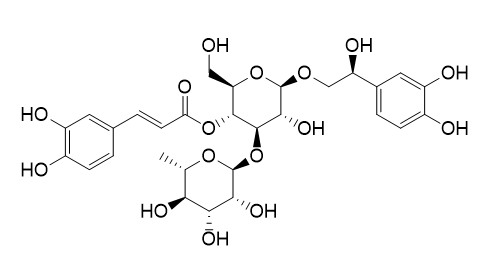beta-Hydroxyacteoside
Inquire / Order:
manager@chemfaces.com
Technical Inquiries:
service@chemfaces.com
Tel:
+86-27-84237783
Fax:
+86-27-84254680
Address:
1 Building, No. 83, CheCheng Rd., Wuhan Economic and Technological Development Zone, Wuhan, Hubei 430056, PRC
Providing storage is as stated on the product vial and the vial is kept tightly sealed, the product can be stored for up to
24 months(2-8C).
Wherever possible, you should prepare and use solutions on the same day. However, if you need to make up stock solutions in advance, we recommend that you store the solution as aliquots in tightly sealed vials at -20C. Generally, these will be useable for up to two weeks. Before use, and prior to opening the vial we recommend that you allow your product to equilibrate to room temperature for at least 1 hour.
Need more advice on solubility, usage and handling? Please email to: service@chemfaces.com
The packaging of the product may have turned upside down during transportation, resulting in the natural compounds adhering to the neck or cap of the vial. take the vial out of its packaging and gently shake to let the compounds fall to the bottom of the vial. for liquid products, centrifuge at 200-500 RPM to gather the liquid at the bottom of the vial. try to avoid loss or contamination during handling.
Phytother Res.2019, 33(4):1104-1113
Biochem Biophys Res Commun.2020, 522(4):1052-1058
Genes Genomics.2020, 10.1007
VNU J Science: Med.&Pharm. Sci.2024.2588-1132
Food and Fermentation Industries2019, 45(7):45-51
Journal of Life Science2018, 917-922
Universitat Stuttgart2022, opus-12200.
Cell Death Discov.2023, 9(1):350.
Int Immunopharmacol.2022, 106:108603.
Int. J. Mol. Sci.2022, 23(14),7699;
Related and Featured Products
J Nat Med . 2010 Apr;64(2):139-145.
Biosynthesis of acteoside in cultured cells of Olea europaea[Pubmed:
20037799]
Five phenylethanoid glycosides (acteoside, isoacteoside, beta-oxoacteoside, beta-Hydroxyacteoside, and salidroside) were isolated from a cell suspension culture of Olea europaea. We examined the biosynthesis of acteoside in olive cell cultures by using feeding experiments with stable isotope labeled precursors. The hydroxytyrosol moiety of acteoside is biosynthesized from tyrosine through dopamine, whereas the caffeoyl moiety of acteoside is biosynthesized from phenylalanine via a cinnamate pathway. Dopamine is incorporated into acteoside through oxidation to the corresponding aldehyde, reduction to the alcohol, and then beta-glycosylation.
Z Naturforsch C J Biosci . 2007 Sep-Oct;62(9-10):673-678.
Screening for free radical scavenging and cell aggregation inhibitory activities by secondary metabolites from Turkish Verbascum species[Pubmed:
18069239]
Free radical scavenging and cell aggregation inhibitory activities of 36 secondary metabolites isolated from the methanolic extracts of Verbascum cilicicum Boiss., V. lasianthum Boiss. ex Bentham, V pterocalycinum var. mutense Hub.-Mor., and V. salviifolium Boiss. (Scrophulariaceae) were investigated. The isolated compounds, 6-O-vaniloyl ajugol (1), ilwensisaponin A (2), ilwensisaponin C (3), verbascoside (4), beta-Hydroxyacteoside (5), martynoside (6), poliumoside (7), forsythoside B (8), angoroside A (9), dehydrodiconiferyl alcohol-9-O-beta-D-glucopyranoside (10), dehydrodiconiferyl alcohol-9'-O-beta-D-glucopyranoside (11), apigenin 7-O-beta-glucopyranoside (12), luteolin 7-O-beta-glucopyranoside (13), luteolin 3'-O-beta-glucopyranoside (14) and chrysoeriol 7-O-beta-glucopyranoside (15), exhibited a dose-dependent inhibition of bioautographic and spectrophotometric DPPH activities. Verbascoside (4) was the most active (IC50 4.0 microg/ml) comparing it to vitamin C (IC50 4.4 microg/ml) to inhibit phorbol 12-myristate 13-acetate (PMA)-induced peroxide-catalyzed oxidation of 2',7'-dichlorofluorescein (DCFH) by reactive oxygen species (ROS) within human promyelocytic HL-60 cells. Ilwensisaponin A (2) (MIC 6.9 microg/ml) showed moderate in vitro activity on lymphocyte-associated antigen-1 (LFA-1)/intercellular adhesion molecule-1 (ICAM-1)-mediated aggregation using the HL-60 cell line [positive control was cytochalasin B (MIC 2.3 microg/ml)]. None of the other compounds showed free radical scavenging and cell aggregation inhibitory activities.



